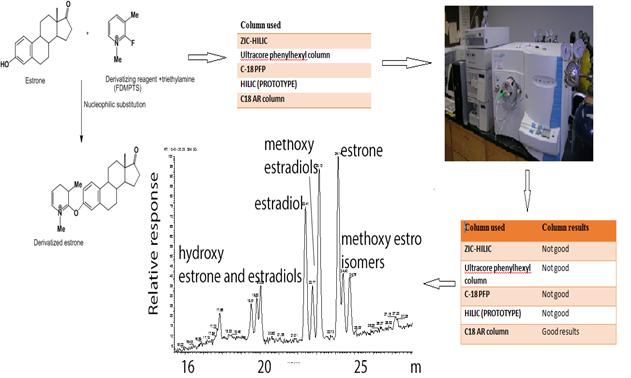A COMPARATIVE ASSESSMENT OF THE EFFICIENCY OF HPLC COLUMNS AND CHROMATOGRAPHIC CONDITIONS IN LC-MS ANALYSIS OF DERIVATISED ESTROGEN HORMONES AND THEIR METABOLITES
DOI:
https://doi.org/10.71146/kjmr231Keywords:
LTQ Orbitrap, Mass Spectrometer, derivatization, liquid chromatography, estrone, estradiolAbstract
Determination of estrone, estradiol, and their metabolites is a very challenging task as its ionization and determination offer considerable difficulties. Different types of HPLC columns were used in different conditions in order to get the best separation. Derivatives of estrone, estradiol, and their metabolites were produced by using a derivatization agent 2-Fluoro-1, 3-dimethylpyridinium p-toluene sulfonate, followed by the chemical analysis using different types of columns. Different combinations of mobile phases were also investigated and the best separation was achieved with Mobile phase A and B consisted of 0.1% v/v formic acid in water and acetonitrile respectively, used in a gradient method. Different concentrations of estrone, estradiol and their metabolites for calibration curves were prepared, derivatized with the reagent and were analysed by LC-MS technique. The derivatives produced by this method have shown several times higher detection response. Using this derivatization method, spiked standards of estrone, estradiol and their metabolites were analyzed and the method was then applied to culture media samples for determination of estrogens hormones. The results suggested that the best resolution of estrogens and their metabolites and peak shapes were obtained by using C18-AR columns and Thermo Orbitrap mass spectrometer as compare to the other HPLC columns.
Downloads

Downloads
Published
Issue
Section
License
Copyright (c) 2025 Muhammad Abbas, Mohammad Ikram, David G Watson, Tayyaba iftikhar, Abdul Saboor, Muhammad Sohail Anwar, Abdullah (Author)

This work is licensed under a Creative Commons Attribution 4.0 International License.






